

A Walk Through Dementia - walking home. Drawing Room: 360º virtual reality. End to End Cinematic VR Production Best Practices. Not a Film and Not an Empathy Machine – Immerse. With the arrival of the first generation of consumer headsets, virtual reality has produced a wealth of exploratory projects from a diverse group of very talented practitioners including game designers, animators, documentary journalists, Hollywood filmmakers, social activists, university researchers, and visual artists.

Most of what these adventurous folks (myself and my students included) are producing is terrible, which is just as it should be. Expanding human expressivity into new formats and genres is culturally valuable but difficult work. We are collectively engaged in making necessary mistakes, creating examples of what works and what doesn’t work for one another to build on. The technical adventurism and grubby glamour of working in emerging technologies can make it hard to figure out what is good or bad from what is just new.
Confusion One: VR is not a film to be watched but a virtual space to be visited and navigated through. Therefore: For example: VR is not film. So what is it? – Immerse. I’m grateful to Janet Murray for reminding us that, at least when it comes to media, we tend to back into the future.
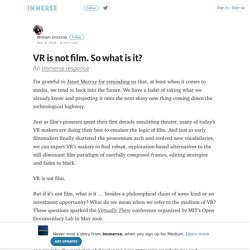
We have a habit of taking what we already know and projecting it onto the next shiny new thing coming down the technological highway. Just as film’s pioneers spent their first decade emulating theater, many of today’s VR makers are doing their best to emulate the logic of film. And just as early filmmakers finally shattered the proscenium arch and evolved new vocabularies, we can expect VR’s makers to find robust, exploration-based alternatives to the still-dominant film paradigm of carefully composed frames, editing strategies and fades to black. Towards a VR Manifesto – Immerse. I love manifestos.

VR is not film. So what is it? – Immerse. I’m grateful to Janet Murray for reminding us that, at least when it comes to media, we tend to back into the future.
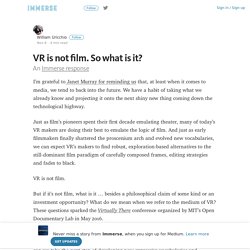
We have a habit of taking what we already know and projecting it onto the next shiny new thing coming down the technological highway. Just as film’s pioneers spent their first decade emulating theater, many of today’s VR makers are doing their best to emulate the logic of film. And just as early filmmakers finally shattered the proscenium arch and evolved new vocabularies, we can expect VR’s makers to find robust, exploration-based alternatives to the still-dominant film paradigm of carefully composed frames, editing strategies and fades to black.
Towards a VR Manifesto – Immerse. I love manifestos.
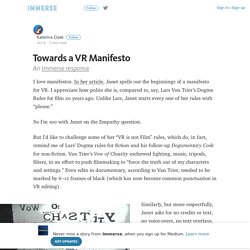
In her article, Janet spells out the beginnings of a manifesto for VR. I appreciate how polite she is, compared to, say, Lars Von Trier’s Dogme Rules for film 20 years ago. Unlike Lars, Janet starts every one of her rules with “please.” So I’m 100 with Janet on the Empathy question. Not a Film and Not an Empathy Machine – Immerse. With the arrival of the first generation of consumer headsets, virtual reality has produced a wealth of exploratory projects from a diverse group of very talented practitioners including game designers, animators, documentary journalists, Hollywood filmmakers, social activists, university researchers, and visual artists.
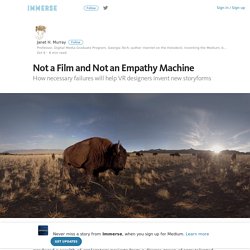
Most of what these adventurous folks (myself and my students included) are producing is terrible, which is just as it should be. Expanding human expressivity into new formats and genres is culturally valuable but difficult work. We are collectively engaged in making necessary mistakes, creating examples of what works and what doesn’t work for one another to build on. The technical adventurism and grubby glamour of working in emerging technologies can make it hard to figure out what is good or bad from what is just new. Confusion One: VR is not a film to be watched but a virtual space to be visited and navigated through. Therefore: For example: Towards a VR Manifesto – Immerse. I love manifestos.

In her article, Janet spells out the beginnings of a manifesto for VR. I appreciate how polite she is, compared to, say, Lars Von Trier’s Dogme Rules for film 20 years ago. Unlike Lars, Janet starts every one of her rules with “please.” So I’m 100 with Janet on the Empathy question. Virtual Strangers – Leap Motion Gallery. This virtual reality app requires the use of an HTC Vive or Oculus Rift, a mounted Leap Motion Controller (using the VR Developer Mount or unofficial alternative), and the Leap Motion Orion software.
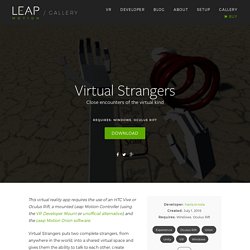
Virtual Strangers puts two complete strangers, from anywhere in the world, into a shared virtual space and gives them the ability to talk to each other, create drawings together, and scale them to mind-bending sizes. This project was featured at the 2016 Toronto International Film Festival (TIFF) as part of The Verge’s summer series POP, which explores all facets of VR storytelling. By Mike Harris & Alec Slayden. Collisions: A virtual reality film by Lynette Wallworth. Untitled. The Storyteller’s Guide to the Virtual Reality Audience — Stanford d.school. Thank You The extended team: Paisley Smith, Judeth Oden Choi, Alexandra Garcia, Amy Santamaria, Joseph Lim, Maya Hawke and Emily Goligoski.

As well as the test participants & actors. News, Non-fiction, Documentary in the 3D virtual space. Visualisez le changement climatique avec la réalité virtuelle. Le casque de réalité virtuelle Oculus Rift de Facebook n’est pas encore entré sur le marché, que déjà la réalité virtuelle commence à se faire une place dans plusieurs domaines.

Le cinéma, le sport ou encore le commerce. Qu’en est-il de la science ? Expérimenter l’empathie L’innovation pourrait bientôt ne plus connaître de frontière infranchissable. En tout cas, plusieurs équipes de recherche tentent d’y parvenir et pourraient être aidées par la réalité virtuelle. Le laboratoire d’étude sur l’interaction humaine virtuelle de l’université de Stanford, a conçu une expérimentation visant à appliquer le principe de l’empathie à tous les domaines du vivant. Une autre expérience a conçu été conçu afin de permettre de visualiser les effets de l’action humaine sur l’environnement et notamment l’énergie dépensée lors d’un bain chaud.
Pas de vidéo ou d’image de cette expérience ? L'info en 360° : réel apport ou course aux nouvelles technologies. James Pallot, le journalisme immersif.